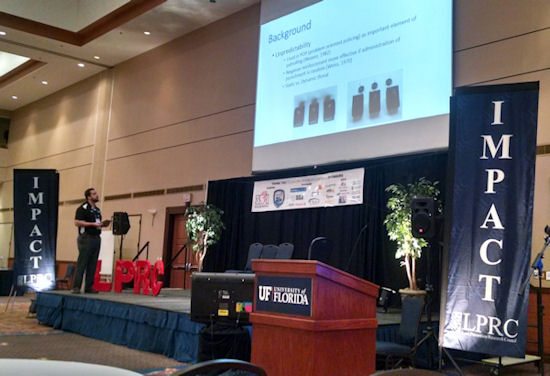|
USS Tactical Tagging Strategy Highlighted
at LPRC Conference

GAINESVILLE, Fla., (October 7, 2015) – The
Loss
Prevention Research Council reported very positive results from its study of
USS’
Tactical Tagging™ strategy at this year’s LPRC Impact Conference in
Gainesville, Fla. The study, conducted in cooperation with a major retailer,
showed that
USS’ Tactical Tagging approach creates a major deterrent to theft by
creating uncertainty in the offender’s mind about what the tag might do if
tampered with.
“Offenders dislike not knowing what will happen next, or how something works”
said Mike Giblin, an LPRC research scientist in his conference presentation to
over 200 LP professionals. “They love being in control: ‘I know what this is, I
know how it works, I know what will happen if I try to steal it.’”
USS Tactical Tagging consists of using EAS tags that look identical, but have
different levels of protection. The one-alarm tags have the lowest cost and
offer one level of protection; three-alarm tags have the highest cost and offer
three levels of protection; two-alarm tags are in-between.
A retailer has the opportunity to mix and match the number of tags from each
category to fit its budget and shrink level at each store. But to an offender,
all tags look like three-alarm tags: alarm speaker, blinking LED light,
aggressive look.
LPRC research involved 10 actual offenders who were shown Tactical Tags and
asked for feedback. “100 percent were very concerned about them,” said Giblin.
Some of the comments from the offenders include:
- “I can see the speaker inside, I know it has a speaker built in.”
- “Very clever.”
- “If I can’t tell what’s real and will alarm, I don’t bother stealing.”
Giblin reported that, of the offenders interviewed, “none could tell the
difference between the tags.” He added that “offenders assumed a high level of
technological ability,” and that prior research showed there is the tendency for
“the offender to think that there is more to the protection measure than there
is.”
“Once debriefed on tags being different, offenders expressed strong dislike for
uncertainty,” said Giblin. “Even truth is a deterrent,” he concluded.

LPRC research scientist Mike Giblin explains the science
behind USS’ Tactical Tagging approach
For more information, contact:
Bané Obrenovich
USS
(909) 484-7870
bane@ussinnovate.com
|